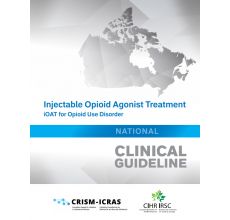Injectable Opioid Agonist Treatment iOAT for Opioid Use Disorder

Canadian Research Initiative in Substance Misuse (CRISM)
-
ndividuals with severe opioid use disorder who inject opioids and have not adequately benefited from oral opioid agonist treatment face substantial risks, including premature death, nonfatal overdose, blood-borne infectious diseases, violence and arrest.
-
Individuals with severe opioid use disorder who inject opioids may not benefit adequately from oral opioid agonist treatment medications, for a variety of reasons.
-
This guideline recommends that injectable opioid agonist treatment be considered for individuals with severe, treatment-refractory opioid use disorder and ongoing illicit (nonmedical or illegal or both) injection opioid use.
-
For patients who are determined to be likely to benefit from injectable opioid agonist treatment, both diacetylmorphine and hydromorphone are acceptable treatment options.
-
Injectable opioid agonist treatment should be provided as an open-ended treatment, with decisions to transition away from injectable opioid agonist treatment made collaboratively with the patient.
The European Commission is preparing a third phase of this programme, therefore COPOLAD will be back at the beginning of 2021.

